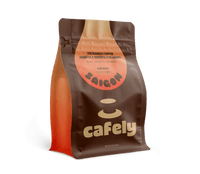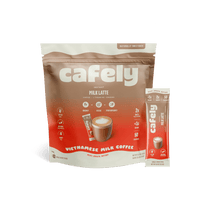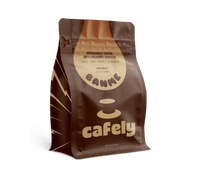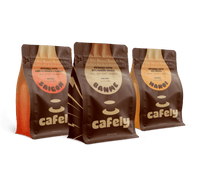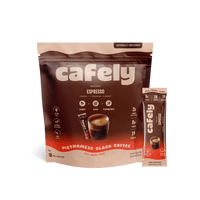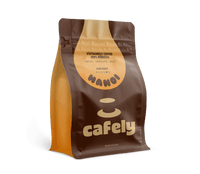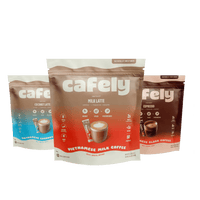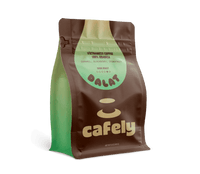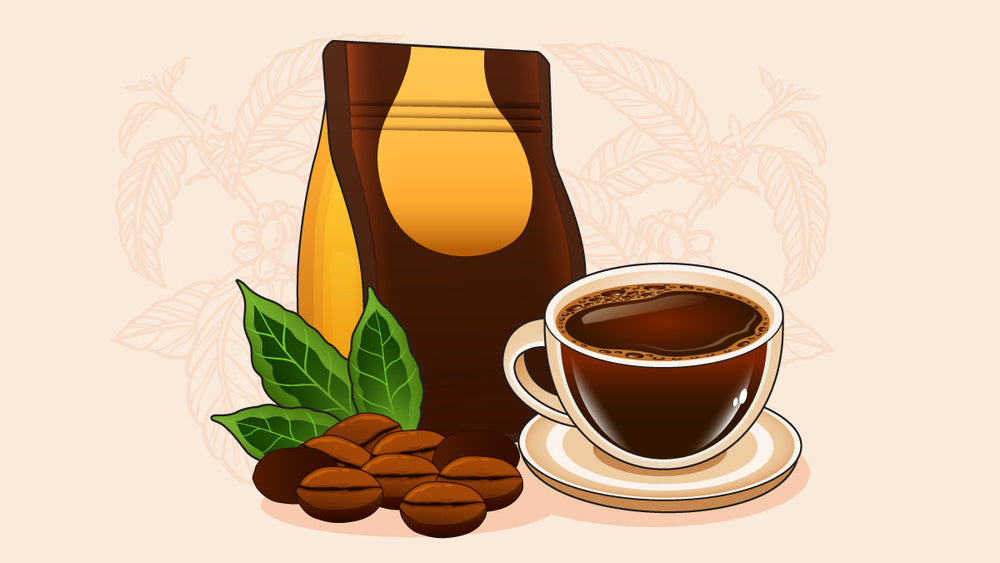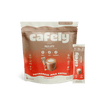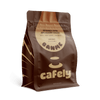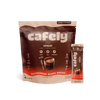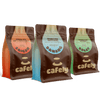Are you looking for bold, dark, chocolatey flavors and potent caffeine content in your morning coffee? Robusta beans are the perfect option. However, bean quality is the difference between a deliciously robust cup and an overly bitter, dull cup. Choosing the right brand is essential.
In this guide, we review five of the best robusta coffee brands, starting with our own prized Vietnamese Robusta. We also cover some key features of robusta coffee and the best ways to brew it to ensure every cup delivers on flavor and caffeine.
Roundup: The Best Robusta Coffee Brands
From dark and potent roasts to artistic approaches to blending, the brands below showcase robusta at its best.
Here are our top picks for robusta coffee brands:
- Cafely (Best Robusta Coffee Overall)
- Nguyen Coffee Supply
- Death Wish Coffee
- Nam Coffee
- Cannonball Coffee
1. Cafely [Best Overall]
Cafely is an authentic Vietnamese coffee brand with a particular love of robusta beans. Almost all of its coffee products contain robusta, and two stand out with 100% robusta content.
The HaNoi coffee is a wonderfully authentic tribute to the coffee culture of HaNoi — Vietnam’s capital city. The smooth, butter-roasted flavor of the beans highlights the country’s traditional coffee culture. You’ll find incredible robusta coffee like this in every cafe in the city, offering a potent caffeine hit and an intense flavor.
These beans are a perfect option to bring a slice of Vietnamese coffee culture into your home — a potent, earthy flavor with chocolate and malt notes from the dark and luxurious roast.
For something even stronger, BanMe (100% peaberry robusta) fits the bill. Peaberry robusta is the strongest type of coffee on the planet and boasts flavors of dark chocolate, burnt sugar, and black cherry.
2. Nguyen Coffee Supply
Nguyen Coffee Supply is another impressive company that champions both robusta beans and Vietnamese coffee. The company was founded by Sahra Nguyen, who had a long and complex creative career before pursuing her love of coffee. A first-generation Vietnamese immigrant to the US, Nguyen has partnered with a fourth-generation farmer in Vietnam’s central highlands to bring the joys of robusta to the world.
The roasting is done on US soil using modern processing techniques, giving these beans a fresh and delicious quality. The company’s coffee is so popular that it’s earned awards and praise from many big names — including a mention in the Wall Street Journal.
Nguyen Coffee Supply is an advocate for robusta beans, despite the stigma around the species. They offer a number of tasty and popular coffee blends, including “Truegrit” — made from 100% peaberry robusta for maximum caffeine.
3. Death Wish Coffee
With a name like Death Wish, you can imagine what their leading products are packed with — dark roast robusta with a potent flavor and a high caffeine content. Founded in 2012, Death Wish Coffee has championed robusta for its bold flavor and intense caffeine content.
All of the company’s coffee is USDA-certified organic, meaning it’s free from harmful chemicals and pesticides. The products are also Fairtrade, ensuring farmers receive fair prices for sustainably grown beans. Interestingly, none of its coffee is sourced from Vietnam, which is unusual for a company that sells mostly robusta. Instead, the beans are sourced from India, Ethiopia, Sumatra, and several locations in Central and South America.
4. Nam Coffee
Nam Coffee is another company passionate about the complexity and flavors of traditional Vietnamese coffee. Vince Nguyen — the founder of Nam — moved from Vietnam to California to pursue a fashion career before lamenting the lack of Vietnamese coffee around him. Having grown up helping his mother with her coffee stand in Saigon, he had a taste of the coffee world and felt obliged to start his own Vietnamese coffee company.
Nguyen sources beans for Nam from a third-generation coffee farmer in Langbiang mountain in Da Lat. This region is at the heart of the Vietnamese Central Highlands and has long produced impressive coffee.
The farm grows both robusta and arabica beans and Nam offers three main options — DaLat (100% robusta), District One (50% arabica, 50% robusta), and Orange County (70% arabica, 30% robusta).
5. Cannonball Coffee
Cannonball Coffee is a British brand launched by Duncan Grocock in March of 2018. Before starting the business, Duncan was a soldier for eight years, and though he drank plenty of coffee in his life, he didn’t have good, strong coffee until meeting Danish soldiers. From there, he began to try different coffees and brewing methods before finding a love for robusta beans.
Now, the company’s primary aim is to share their selected Rwandan robusta coffee with the world. This particular robusta option was selected for flavor — Cannonball roasts it to a medium level, creating a smoother and lighter option than other robusta options on the market.
All four of Cannonball Coffee’s products contain Rwandan robusta beans, but there’s only one without arabica beans. “Iron Bar Espresso” contains Ethiopian arabica and Rwandan robusta, while the other two contain Brazilian alternatives. Grocock’s impressive dedication to flavor has led to this unique collection of products.
What Is Robusta Coffee?

Over 120 species of coffee plants exist across our beautiful planet, and the two most popular ones for drinking are arabica and robusta.
Let’s look into the qualities of robusta coffee:
Bean Composition
The robusta coffee plant (Coffea canephora var. robusta) is hardier than the arabica plant. This is partly due to the high caffeine content. Robusta beans contain around 2.7% caffeine, and arabica beans have around 1.5%. Caffeine is a natural insecticide — protecting the robusta plants from pests and potentially fungi.
The beans the plants produce are a little different, too. Arabica beans are ovular, flat, and slightly oilier than robusta beans, which are smaller and rounder. The arabica beans have a higher lipid (fat), and sugar content. This difference means arabica beans are generally smoother and sweeter, while robusta beans are earthier, stronger, and slightly more bitter.
Flavor Profile of Robusta
Robusta beans produce a bold, dark, robust cup of coffee that’s less sweet than arabica.
Generally, robusta beans are roasted darker to caramelize their relatively low sugar content and create a dark, earthy, mildly sweet drink. Light roast robusta beans can taste harsh, bitter, and overly earthy.
Due to their higher sugar content and lower caffeine levels, arabica coffee beans can be roasted a little more lightly to create a drink that retains more of the raw beans' fruity, acidic, and citrus notes.
Where Is Robusta Coffee From?
With the advent of the internet and international shipping, you can find robusta coffee beans grown all across the world. One place it is particularly beloved is Vietnam, which has a long history with the plant and is still one of the top producers of robusta beans today.
Robusta beans were first introduced to Southeast Asia by French colonists. However, its production only took off on a major scale during the mid-1800s when a severe blight of coffee rust decimated arabica crops in the region.
The robusta plant — which was hardier to the rust — grew well in the region and was quickly adopted and enjoyed by the locals and the colonists. Coffee plants of the time weren’t grown with the knowledge and science we have now, so the beans adopted a poor reputation.
Many people still view robusta as “arabica’s cheaper, low-quality cousin.” However, farming and processing techniques have improved dramatically and we’re beginning to see high-quality robusta coffee available from online brands and specialty coffee shops selling the best coffee online.
What Are the Benefits and Drawbacks of Robusta?
Let’s run through some key benefits and drawbacks of robusta coffee beans compared to arabica beans.
Benefits of Robusta Beans
- Resilient — The Coffea canephora (robusta) coffee plant is much more resilient against disease and insects than the Coffea arabica (arabica) plant, meaning it can be produced in a wider variety of regions.
- Greater yield — The robusta plants offer a greater yield than arabica plants, so farmers can typically get a better return from the crops.
- Espresso culture — Italian espresso culture sometimes uses a mixture of arabica and robusta beans for brewing — around 10–15% by weight. The intense and earthy flavors of robusta beans make for a more full-bodied flavor and creamy texture in the espresso.
- High caffeine content — Robusta beans have almost double the amount of caffeine compared to arabica, perfect for those seeking a more potent pick-me-up.
Drawbacks of Robusta Beans
- Flavor — Because the beans contain half as much sugar and a substantial amount less fat than arabica beans, their natural flavor differs. While some adore the robust, bold, bitter flavor of robusta, it’s not to everyone's taste.
- Roast variation — To get the most sweetness out of the lower sugar content, robusta beans are usually roasted dark, as that’s when the sugars start to caramelize. While you can roast robusta beans more lightly, this doesn’t result in an interesting and complex flavor as arabica.
How to Brew Robusta Coffee

Brewing robusta coffee is a fascinating learning experience, especially if you’ve never had the pleasure of trying the beans before.
Let’s explore some tips for getting the most flavor out of these beans…
Grinding Robusta Beans
Let’s start brewing by grinding. First of all, you must consider that during the roasting process, the beans' cellulose begins to break down. This means that the flavor and aroma chemicals become more water-soluble — which leads to greater potential for extraction.
If you grind the beans too finely, you’re much more likely to over-extract the coffee. We suggest starting with a medium or coarse grind if you’re brewing robusta with a French press, pour-over, drip coffee maker, or phin filter.
Only opt for a fine grind if you’re using a moka pot, Aeropress brewer, or espresso machine.
Preferred Robusta Brewing Methods
Pour-over brewers such as the Chemex brewer and Hario V60 create a wonderfully dark brew with a smooth mouthfeel. If you want to taste the raw flavors of robusta coffee and reveal the bean’s complex flavor notes, pour-over is the way to go.
For a traditional Vietnamese approach to brewing robusta, use a phin filter. The phin is a traditional pour-over brewer from Vietnam that’s been used to create decadent robusta cups for many, many years.
It’s particularly great for this job because of the flat filter plate and gravity press. These two elements work together to increase the contact and pressure between the coffee grounds and the water, leading to rich, dark, concentrated extraction.
Choosing the Best Robusta Coffee Brands
Robusta coffee beans are just as rich and complex as arabica beans, although slightly different in character. With that said, quality matters — perhaps more so than arabica. It’s important to track down the best robusta growers, roasters, and processors to ensure those beautiful flavors reach the final cup.
Here are some things to look out for when looking for the best robusta coffee brands:
- Organically Grown — Coffee grown using organic practices are becoming more popular because of their reduced environmental impact. They also greatly reduce the risk that man-made chemicals make it to your final brew.
- Certified Mold-Free — Mold can leave mycotoxins in coffee beans if they contain too much moisture. These mycotoxins can be harmful to your health. Reputable robusta brands will regularly test for the presence of mold and provide certification, confirming they’re mold-free.
- Sugar-Free — Traditionally, roasters tossed robusta coffee beans with butter and sugar before roasting to mask poor flavors. With modern farming techniques, the coffee bean is sweet enough without sugar, leading to an authentic robusta flavor in every sip.
- Freshly Roasted — Once the coffee is roasted it begins to go stale immediately. By choosing beans with a recent, fresh roasting date, you can ensure the coffee is flavorful and rich.
- Freshly Ground — When you grind coffee beans, you increase their surface area for efficient extraction. However, this also means more air in contact with the beans. Ground coffee goes stale far quicker than whole-bean coffee. By grinding your coffee just before brewing or opting for a fresh pre-ground coffee, you maintain the flavors of the coffee.
- Country of Origin — The best robusta beans come from Vietnam, where the crop has thrived on volcanic soil for generations. Opt for a Vietnamese robusta coffee to get the most complex and elegant flavors.
FAQs: Robusta Coffee
Now that you’ve explored the history and science of robusta coffee beans, check out the answers to the frequently asked questions below.
1. What Are Robusta Coffee Beans?
Robusta beans come from a species of coffee (Coffea canephora) with a bold and bitter flavor. These beans are known for their high caffeine content and bold, robust flavor profile.
2. How Are Robusta Coffee Beans Different From Arabica Beans?
There are lots of differences between arabica and robusta. Most notably, robusta beans have twice the amount of caffeine compared to arabica, while arabica beans have twice as much sugar and fat. These differences lead to their unique flavor characteristics, with robusta being earthier and arabica being more aromatic.
3. How Are Robusta Beans Roasted?
For the most part, the beans are roasted to a very dark level to caramelize the bean’s natural sugars. This brings out their natural sweetness while also showing off their smooth, earthy flavors.
4. How Should I Brew Robusta Coffee?
We would suggest treating robusta coffee as you would any of the best dark roast coffee options — a medium grind and pour-over brew, followed by dialing in to hit the sweet spot for your palate. To get a head start, try brewing with a phin filter — these traditional Vietnamese brewers use a weighted disc, flat filter plate, and vertical sides to get maximum extraction from the beans.
5. Where Do Robusta Beans Come From?
Robusta beans — also known as Coffea canephora — are likely native to the forests of Ethiopia. However, in the modern day, Vietnam is the largest producer of robusta beans in the world.
6. How Many Species of Coffee Are There?
There are over 130 unique species of coffee that have been discovered so far. However, we only farm a few for consumption, and arabica and robusta makeup around 99% of commercial coffee production. Other species such as the underrepresented Liberica type are commercially cultivated in minute quantities compared to arabica and robusta beans.
